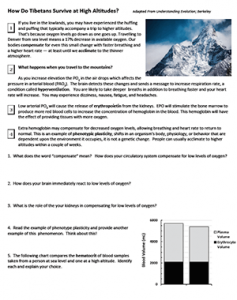
This case was designed for the chapter on the respiratory system for Anatomy and Physiology. It is based on materials from the Berkeley website: Understanding Evolution and Smithsonian. In this version, the focus is on the how the body maintain homeostasis at high altitudes.
For most individuals, this involves increased production of red blood cells to improve oxygen supplies to tissues. Tibetan populations have actually adapted to high altitudes by producing fewer red blood cells.
Students work though the case to discover why having too many RBC’s can be a disadvantage when it comes to reproduction. The lesson also includes a return to the idea of hematocrit, which students learned in earlier chapters on blood. Students will discover that blood becomes thicker at high altitudes and that increases the risk of miscarriage and low birth weight. Lowered production of RBC’s is traced to a change in the EPAS1 gene.
Students compare the presence of this change found in Tibetans to their close relative the Han Chinese. A single nucleotide polymorphism can be used to track differences in the two populations. Overall, this lesson connects genetics, DNA, and evolution to topics in anatomy and physiology.
Students will analyze data from primary sources showing birth weights and prenatal mortality. For more in-depth coverage of the topic, the research can be printed from the Journal of Applied Physiology.
Grade Level: 11-12
Time Required: 45-60 minutes (1.5 class periods)
Students will analyze data from primary sources showing birth weights and prenatal mortality. For more in-depth coverage of the topic, the research can be printed from the Journal of Applied Physiology.

HS-LS1-1 Construct an explanation based on evidence for how the structure of DNA determines the structure of proteins which carry out the essential functions of life through systems of specialized cells
HS-LS1-2 Develop and use a model to illustrate the hierarchical organization of interacting systems that provide specific functions within multicellular organisms
HS-LS4-3 – Apply concepts of statistics and probability to support explanations that organisms with an advantageous heritable trait tend to increase in proportion to organisms lacking this trait.
CCC 6. Structure and function. The way in which an object or living thing is shaped and its substructure determine many of its properties and functions.

